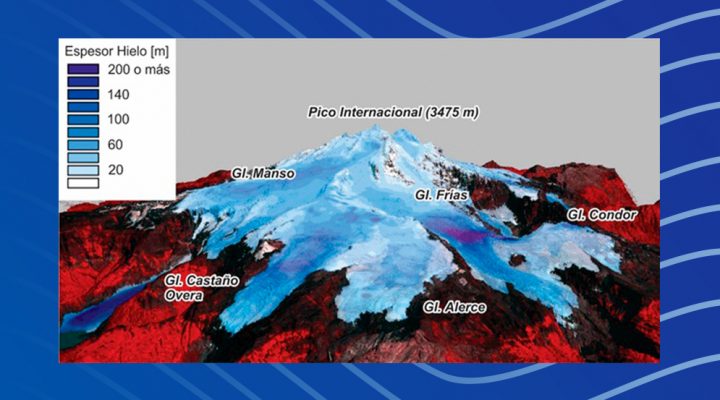SCIENTIFIC PROMOTION
Scientists estimate the thickness and volume of Monte Tronador glaciers
The study was undertaken by CONICET researchers and their colleagues from Chile and Canada.
In Argentina, glaciers are vital components of the mountain hydrological system and are recognized as strategic water reserves for the arid diagonal part of the country. For this reason, knowing how much ice they contain is key to quantifying current and future water availability as well as estimating sea level rise and understanding their response to climate change.
For the first time, a group of experts have recently published a study in which they estimated the volume of ice of Monte Tronador glaciers -located in Río Negro- using a thickness distribution model to obtain results with accuracy of 35 meters.
“Monte Tronador is an extinct stratovolcano located in the Andes of Northern Patagonia along the border between Argentina and Chile. Its upper slopes are the home of one of the region’s most extensive contiguous ice cover and due to to its relative easy access, its glaciers have been analyzed for more than forty years,” says Valentina Zorzut, CONICET doctoral fellow at the ‘Instituto Argentino de Nivología, Glaciología y Ciencias Ambientales (IANIGLA, CONICET-UNCUYO-Gob. Mza), who seeks to enhance the estimates of the volume of ice in the country’s glaciers.
Since 2013, according to Law 26,639, the IANIGLA began a series of studies of the Argentine glaciers of Monte Tronador. In 2015, in collaboration with French scientists, a research team of the institute made the first map of surface velocities for all the ice bodies distributed on the hill.
During the fall of 2018, researchers of IANIGLA and the ‘Laboratorio de Glaciología del Centro de Estudios Científicos de Valdivia’ measured the thickness of glacier Manso. “Thanks to the large amount of previous measurements, we managed to analyze the distribution of ice on the hill in great detail,” Zorzut explains.
So far, the only estimates for the glaciers in the Andes of Argentina and Chile had been made with numerical models made of global-scale glacier inventories and with very few measurements to calibrate and validate the results.
“The thickness of ice in a specific place of a glacier is related to the speed at which it flows and the surface slope. By inverting the equations used to calculate the surface velocity of glaciers, it is possible to estimate the thickness of the ice. Thanks to the surface velocity maps of Monte Tronador glaciers, and the large number of existing ice thickness measurements for these glaciers, we managed to make a model of the ice thickness distribution with accuracy of 35 meters.
The results indicate that the glaciers of Monte Tronador have an average thickness of 75 meters, but in some cases they exceed 240 meters. Together they have an ice volume of 4.8 km3.
“The total volume estimated for the glaciers of Monte Tronador agrees with those obtained by studies on a global scale and without calibration data for these bodies. But the ice distribution, that is where the glaciers are thickest and where they are thinnest, varies. The use of surface velocity maps and a detailed inventory of the glaciers of Monte Tronador allowed us to have a more real ice distribution than studies based on global scale glacier inventories. Enhancing our knowledge on ice distribution in our glaciers is key to understanding their response to future climate changes,” concludes.
References
Zorzut, V.; Ruíz, L.; Rivera, A.; Pitte, P.; Villalba, R.; Medrzycka, D. (2020) “Slope estimation influences on ice thickness inversion models: a case study for Monte Tronador glaciers, North Patagonian Andes”. Journal of Glaciology.
DOI: https://doi.org/10.1017/jog.2020.64
About the study:
Valentina Zorzut. CONICET doctoral fellow (IANIGLA)
Lucas Ruiz. CONICET associate researcher (IANIGLA)
Andres Rivera. Universidad Austral de Chile
Pierre Pitte. CONICET assistant researcher (IANIGLA)
Ricardo Villalba. CONICET senior researcher (IANIGLA)
Dorota Medrzycka. Doctoral fellow (University of Ottawa)
By Leonardo Fernández – CCT Mendoza
